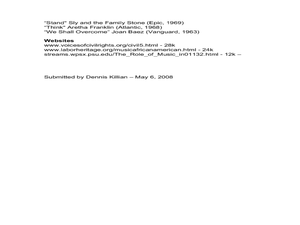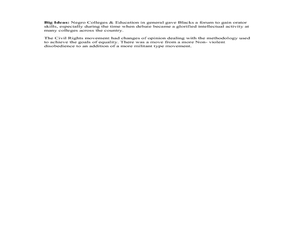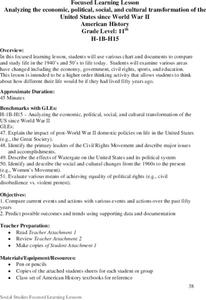National Endowment for the Humanities
Martin Luther King, Jr. and Nonviolent Resistance
Was nonviolent resistance the best means of securing civil rights for black Americans in the 1960s? In this highly engaging and informative lesson, your young historians will closely analyze several key documents from the civil rights...
Curated OER
20th Century Civil Disobedience
Students write from varying perspectives in the American South about the civil rights movements in the 1950s. In this civics lesson, students view video clips and take notes. Students discuss the film and listen to a lecture on...
Curated OER
The Civil Rights Movement
Students explore the events of the Civil Rights Movement. In this research skills lesson, students research the important figures, events, and ideas of the American Civil Rights Movement as they visit suggested websites that feature...
Stanford University
Lesson Plan: The Children's Crusade and the Role of Youth in the African American Freedom Struggle
Young people played significant roles in the Civil Rights movement. Class members examine the contributions of Barbara Johns, Claudette Colvin, Mary Louise Smith, and the children of Birmingham,...
Curated OER
Understanding the Music of the Civil Rights Movement
Students examine protest music and songs from the Civil Rights movement. In this music of the Civil Rights era activity, students listen to selected music before working in groups to determine who the music was directed at, what social...
Curated OER
Keep on Pushing: Popular Music and the Civil Rights Movement
Students explore music that exemplified the Civil Rights Movement. In this music and history lesson, students research 1960's protest songs, Motown recorded music, and rap of the 1990's to consider the power of music and its reflection...
National Endowment for the Humanities
Revolution '67, Lesson 2: What Happened in July 1967? How Do We Know?
Even in a world in which dozens of participants and curious onlookers record every controversial event, the basic facts of what happened are often in dispute. Revolution '67, Lesson 2 explores 1967 Newark, New Jersey using an examination...
Curated OER
Civil Rights Methodology Martin Luther King, Jr. – Stokely Carmichael
Students compare and contrast the visions of Martin Luther King, Jr. and Stokely Carmichael. In this African-American history lesson, students read speeches by each of the men and summarize the arguments made by each of them about...
National Endowment for the Humanities
Revolution '67, Lesson 1: Protest: Why and How
To some people, protesting is as American as apple pie, but the factors that lead to protests can be as confusing to veteran activists as to today's youth. Revolution '67 explores the riots in Newark, New Jersey as a case study. Using...
Intersectional Black Panther Party History Project, IPHP
Teaching the History of the Black Panther Party: 5 Essential FAQ’s
What are the facts about the Black Panther Party? Was it, as J. Edgar Hoover contended, a terrorist organization and a threat to national security? Or a group of indviduals bound together by a desire to protect and nurture their...
Curated OER
Concept Attainment
Students are introduced to the topic of civil disobedience. Using a historical event, they identify the disobedience act in the event. They explain the significance that civil disobendience played in the events of the 1960s. They write a...
Curated OER
Analyzing the economic, political, social, and cultural transformation of the United States since World War II
Eleventh graders examine political issues in the United States between 1936 and 2000. For this American history lesson, 11th graders study the economy, education, government, civil rights, and sports of this time period. Students compare...
Curated OER
Court Documents Related to
Young scholars use the National Archives to researcj cout coduments related to Martin Luther King, Jr.
Curated OER
Rockin’ the World: Rock and Roll and Social Protest in 20th Century America
Students explore protest songs. In this interdisciplinary lesson, students examine issues-based music by summarizing lyrics and revealing inferences, generalizations, conclusions, and points of view found in the songs.
Curated OER
Making the Movie Antigone
Young scholars create a movie prospectus for Antigone being faithful to the major themes and conflict. They include the plot, setting, characters, and conflict while making them relevant to contemporary audiences.
Curated OER
Focused Learning Lesson
Eleventh graders analyze charts and primary source documents to compare life in the 1940s and 1950s. They are encouraged to examine the economy, government, sports and education.
Khan Academy
Khan Academy: Us History: 1945 1980: Sncc and Core
Read about the two civil rights groups that organized nonviolent protests during the 1950s and 1960s.


















